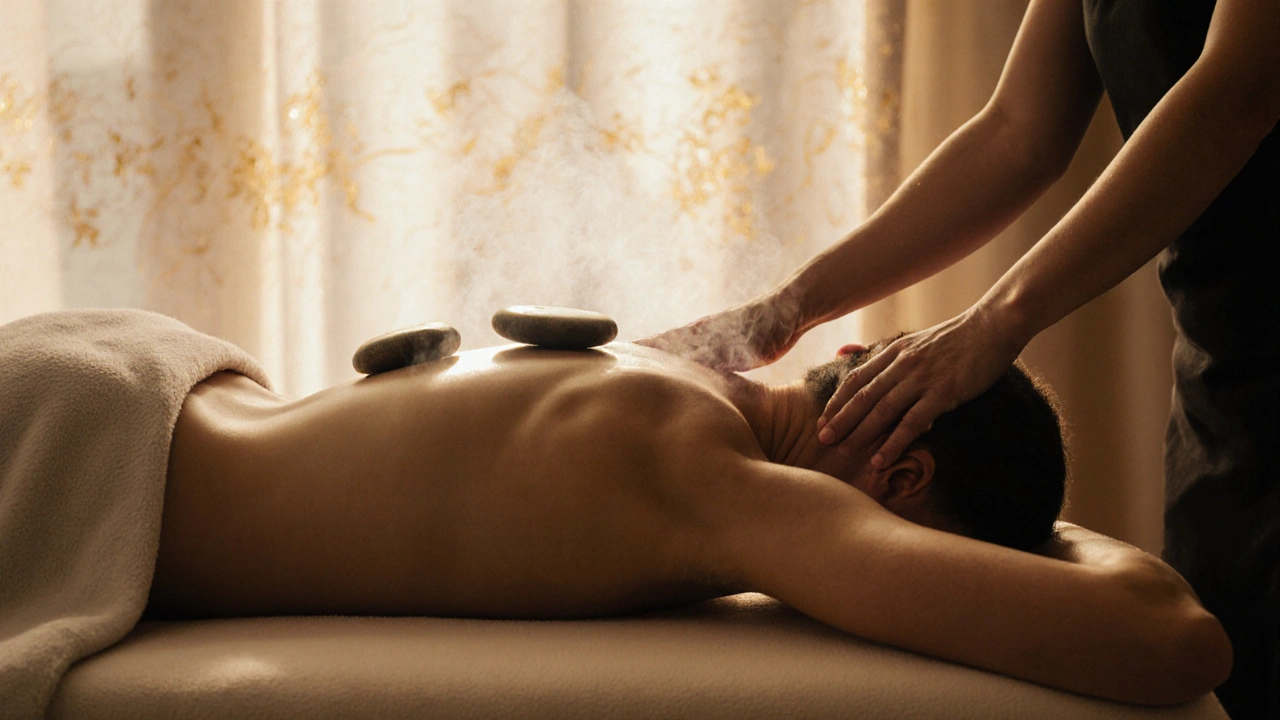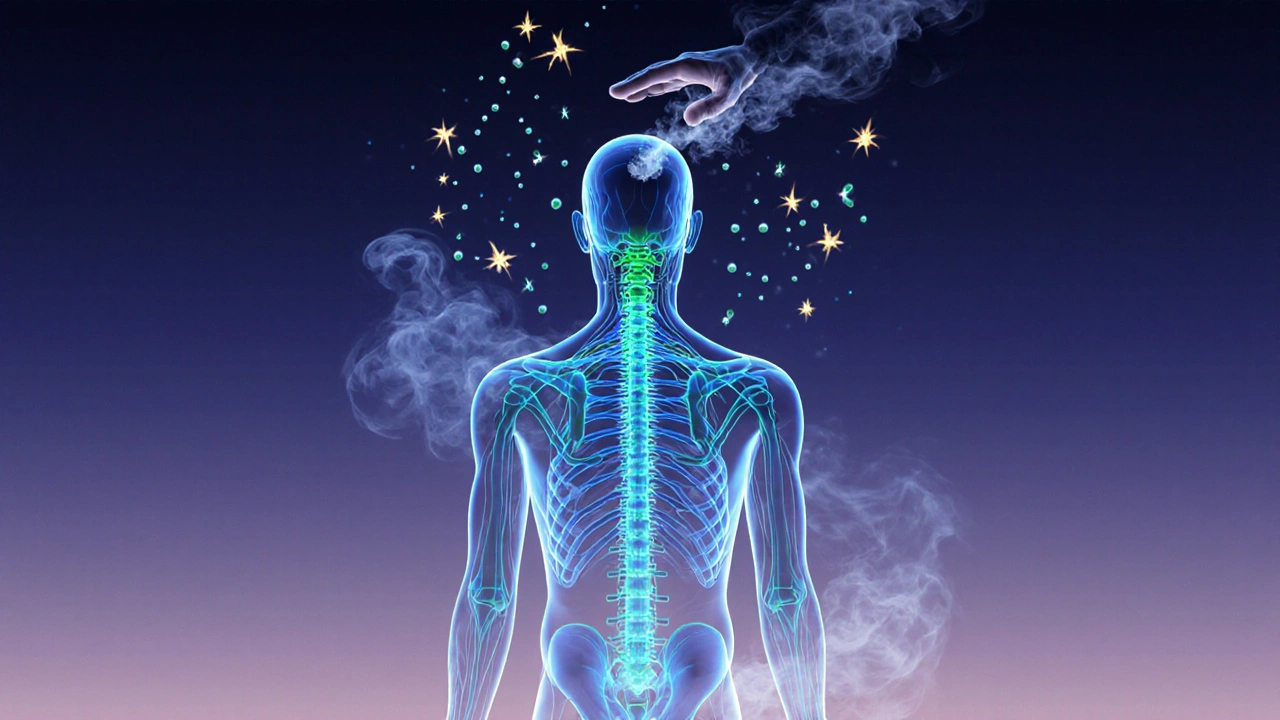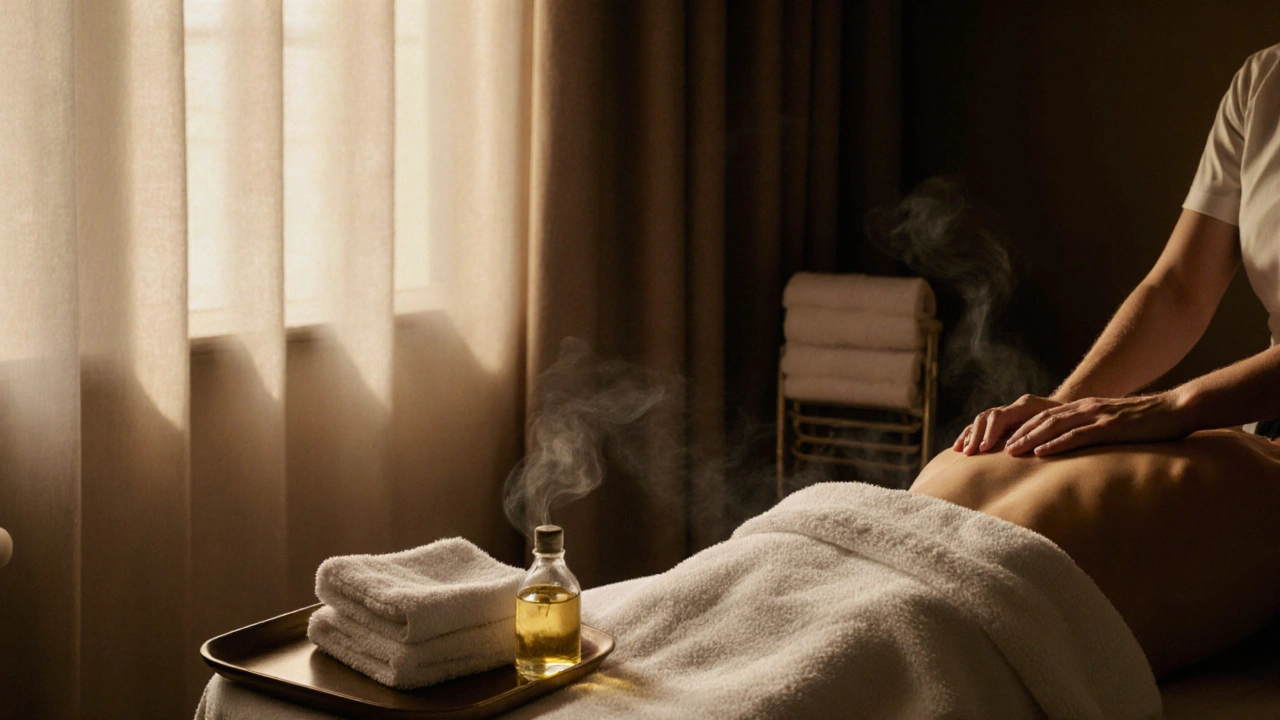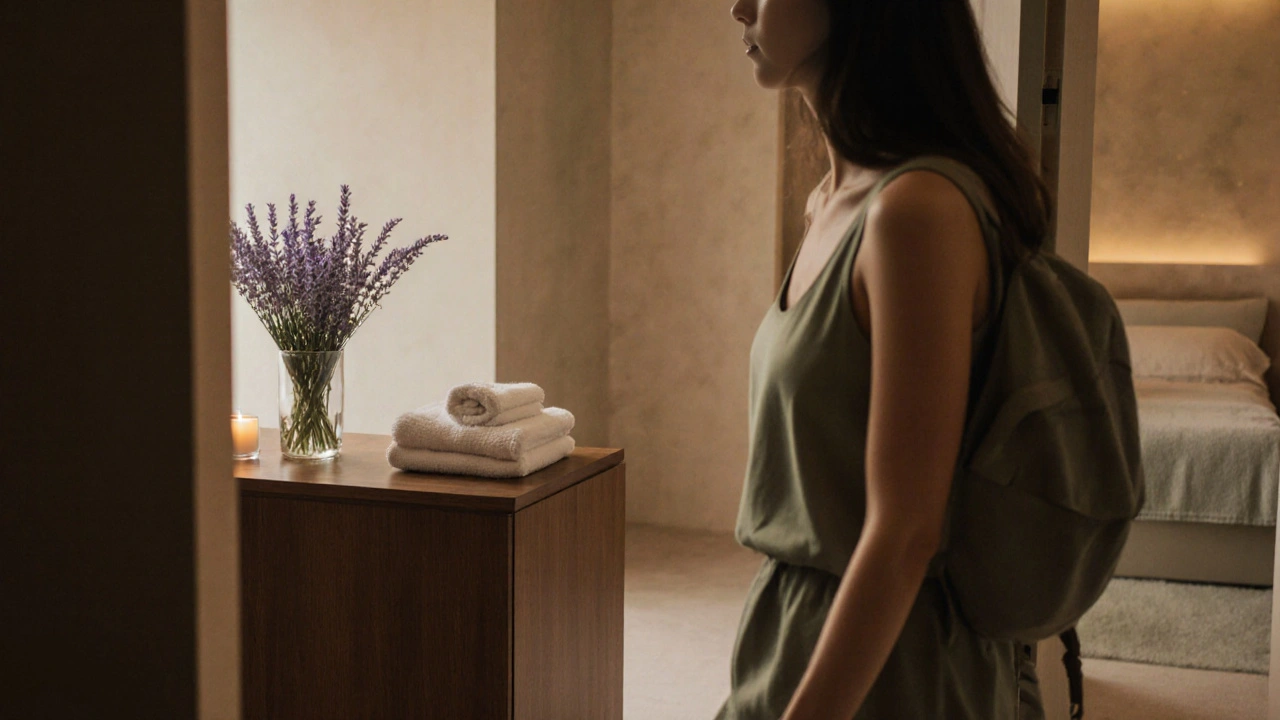The Mind-Body Connection: How Massage Therapy Benefits Both Mental and Physical Health

When you get a massage, you’re not just relaxing your muscles. You’re resetting your nervous system, calming your mind, and giving your body a chance to heal. It’s not magic-it’s biology. The way your body responds to touch is deeply wired into how you feel emotionally, mentally, and physically. Massage therapy doesn’t just ease sore shoulders or tight hips. It changes your brain chemistry, lowers your stress hormones, and helps you sleep better. If you’ve ever felt calmer after a massage, you weren’t imagining it. Science backs it up.
What Happens to Your Body During a Massage
When a therapist applies pressure to your muscles, your body reacts in real time. Blood flow increases, bringing oxygen and nutrients to tired tissues. Lactic acid and other metabolic waste get flushed out. Your muscles loosen, and stiffness decreases. But that’s only half the story.
Touch triggers your parasympathetic nervous system-the part of your body responsible for rest and repair. This is the opposite of your fight-or-flight response. As your body shifts into this mode, your heart rate slows, your breathing deepens, and your blood pressure drops. A 2023 study in the Journal of Clinical Medicine found that people who received weekly massage therapy for eight weeks had an average 31% reduction in cortisol, the main stress hormone. That’s the same drop seen in people who meditate daily.
Massage also boosts serotonin and dopamine. These are the chemicals linked to mood, motivation, and pleasure. Low levels of these neurotransmitters are tied to anxiety and depression. A single 60-minute session can raise serotonin levels by up to 28%, according to research from the University of Miami’s Touch Research Institute. You don’t need pills or therapy sessions to get this effect-just steady, intentional touch.
How Massage Calms the Mind
Think about the last time you felt overwhelmed. Your jaw was clenched. Your shoulders were up by your ears. Your thoughts raced. That’s your body screaming for relief. Massage doesn’t just mask that-it reverses it.
Chronic stress keeps your nervous system stuck in high gear. Over time, that leads to insomnia, brain fog, irritability, and even digestive problems. Massage breaks that cycle. The rhythmic pressure of hands on skin sends signals to your brain that say: you are safe. This isn’t just psychological. It’s neurological. Your brain starts producing more alpha waves-the same brainwaves you get during deep relaxation or light meditation.
People who struggle with anxiety often report feeling more grounded after a massage. One woman in Bristol, who came in for regular sessions after losing her job, told me she stopped having panic attacks within three weeks. She didn’t start therapy. She didn’t change her diet. She just started getting weekly massages. Her doctor noticed her resting heart rate dropped from 82 to 64 beats per minute.
The Physical Benefits Are Real-and Measurable
Massage therapy isn’t just for athletes or people with chronic pain. It helps anyone who sits at a desk, carries kids, stands on their feet all day, or sleeps poorly.
For people with lower back pain, massage is as effective as physical therapy in reducing discomfort, according to a 2024 review in the Annals of Internal Medicine. After four sessions, participants reported 50% less pain and improved mobility. For those with neck tension from phone use or computer work, massage reduces muscle hardness by up to 40% in just one session, per a study from Tokyo Medical University.
It also helps with recovery. After a workout, massage reduces inflammation markers like IL-6 by 30%. That means less soreness, faster recovery, and better performance next time. Even people who don’t exercise benefit. One 72-year-old woman in Bristol started getting biweekly massages for arthritis. Within two months, she was able to walk to the shops without her cane.
Massage as a Tool for Better Sleep
Sleep and stress are locked in a loop. Poor sleep raises cortisol. High cortisol makes sleep harder. Massage breaks that loop.
Studies show that massage increases melatonin-the hormone that tells your body it’s time to sleep-by up to 30%. People who get regular massage fall asleep faster, stay asleep longer, and report deeper, more restful sleep. One 2022 trial with insomniacs found that those who received massage three times a week for six weeks improved their sleep quality by 55%, compared to just 12% in the control group.
You don’t need a full-body session either. Even 15 minutes of scalp or foot massage before bed can trigger the same response. Many of my clients now keep a small bottle of lavender oil on their nightstand and use it with light pressure on their temples and neck. It’s simple. It’s cheap. And it works.

Who Benefits Most From Massage Therapy?
Massage isn’t a luxury. It’s a tool. And like any tool, it’s most useful for those who need it most.
- People with chronic stress: Office workers, caregivers, nurses, and parents often carry tension in their necks and shoulders. Massage helps reset their nervous system.
- Those with anxiety or depression: Massage boosts mood chemicals without side effects. It’s a natural complement to therapy.
- People with pain conditions: Fibromyalgia, arthritis, migraines, and sciatica all respond well to regular massage.
- Athletes and active people: Faster recovery, fewer injuries, improved flexibility.
- Older adults: Improved circulation, reduced stiffness, better balance, and less reliance on painkillers.
One man in his late 60s came in every two weeks after hip surgery. He stopped taking his opioid pain meds within six months. His doctor was stunned. He didn’t say it was the massage. But he didn’t need to.
What Kind of Massage Works Best?
Not all massages are the same. The technique matters less than consistency. But here’s what the data says about common styles:
| Massage Type | Best For | Key Benefit |
|---|---|---|
| Swedish Massage | Stress relief, relaxation | Reduces cortisol, boosts serotonin |
| Deep Tissue Massage | Chronic pain, muscle knots | Breaks down adhesions, improves mobility |
| Aromatherapy Massage | Anxiety, sleep issues | Lavender and chamomile oils enhance calm |
| Hot Stone Massage | Stiffness, circulation | Heat relaxes muscles deeper than hands alone |
| Thai Massage | Flexibility, energy flow | Combines stretching and acupressure |
For most people, starting with Swedish or aromatherapy is the best way to feel the mind-body shift. If you’re dealing with pain, deep tissue makes sense. If you’re struggling to sleep, add essential oils. The goal isn’t to find the "best" technique-it’s to find the one you’ll keep doing.
How Often Should You Get a Massage?
You don’t need to go every week. But consistency matters more than intensity.
For general stress relief: Once a month keeps your nervous system balanced.
For chronic pain or high stress: Once every two weeks for 6-8 weeks, then taper to monthly.
For recovery after injury or intense training: Weekly for 4-6 weeks, then biweekly.
Many people think massage is expensive. But when you consider the cost of sleepless nights, anxiety meds, physical therapy visits, or missed workdays-it’s one of the most cost-effective health investments you can make. A single session costs less than a monthly coffee subscription. And it doesn’t just perk you up-it reboots you.

What to Expect on Your First Visit
If you’ve never had a massage, it’s normal to feel unsure. You don’t need to know what to say. You don’t need to be flexible or "in shape." You just need to show up.
Your therapist will ask about pain points, medical conditions, and what you hope to get out of the session. Tell them if you’re sensitive to pressure. Tell them if you’re nervous. They’ve heard it all.
You’ll be covered with a towel. Only the part being worked on is exposed. You’ll be alone in the room. You can leave the lights off. You can fall asleep. You can talk. You can stay quiet. There’s no right way to receive a massage-only what feels right for you.
Afterward, drink water. Your body is flushing out toxins. You might feel a little sore for a day-especially if it was deep tissue. That’s normal. You’ll also feel lighter. Calmer. Like you’ve been reset.
Why This Isn’t Just a Trend
Massage therapy isn’t new. Ancient Egyptians, Greeks, and Chinese used touch for healing thousands of years ago. What’s new is the science proving it works.
It’s not about pampering. It’s about physiology. Your skin is your largest sensory organ. It’s constantly sending signals to your brain. When those signals are calm and safe, your whole body follows.
Massage therapy isn’t a cure-all. But for stress, pain, sleep, and emotional balance, it’s one of the most reliable, side-effect-free tools we have. You don’t need a gym membership. You don’t need an app. You just need someone to press gently into your back and remind your body that it’s okay to rest.
Can massage therapy help with anxiety?
Yes. Massage reduces cortisol and increases serotonin and dopamine-chemicals that regulate mood. Studies show people with generalized anxiety disorder experience significant symptom reduction after regular massage, often comparable to cognitive behavioral therapy. It’s not a replacement for professional mental health care, but it’s a powerful support tool.
Is massage safe if I have a medical condition?
Most people can safely receive massage, but it’s important to tell your therapist about any conditions like blood clots, osteoporosis, cancer, or recent surgery. Some techniques may need to be adjusted. A licensed therapist will know how to modify the session to keep you safe. Always consult your doctor if you’re unsure.
How long does it take to feel the benefits?
Many people feel calmer and less tense immediately after a session. Physical relief from pain or stiffness can take 1-3 sessions. For lasting changes in stress levels or sleep quality, most people need 4-6 weekly sessions. The benefits build over time, like exercise or meditation.
Do I need to undress completely?
No. You can keep your underwear on. Most therapists use draping techniques to cover you at all times. Only the area being worked on is exposed. Your comfort comes first. If you’re uncomfortable, speak up. A good therapist will adjust without judgment.
Can I do massage at home?
You can’t replicate a professional massage, but you can get some benefits at home. Use a foam roller for your back, a tennis ball for your feet, or a gentle hand massage on your neck and shoulders. Adding lavender oil or warm compresses helps. But for deep tension, chronic pain, or mental stress, professional touch is more effective. It’s not about replacing therapy-it’s about supporting it.
Where to Start
If you’re ready to try massage therapy, look for a licensed therapist with experience in the kind of work you want-relaxation, pain relief, or stress reduction. Ask about their training. Check reviews. Don’t go to the cheapest option-go to the one who listens.
Start with a 60-minute Swedish or aromatherapy session. Give yourself time to feel the difference. Don’t expect a miracle on day one. But if you feel even a little calmer, a little lighter, a little more like yourself-that’s the mind-body connection working.
You don’t have to wait until you’re broken to start taking care of your body. Sometimes, healing begins with someone’s hands on your back-and your own willingness to let go.




Shaun Chooi
November 27, 2025 AT 12:59I got my first massage after a breakup and honestly? It was the first time in months I felt like I could breathe again. Not because someone was rubbing my back, but because for 60 minutes, my brain stopped screaming. I cried during the session. Didn’t even know I needed to until it happened. Now I go every two weeks. No therapy. No meds. Just hands and pressure and silence. It’s wild how something so simple fixes what pills can’t.
Deepak Raj Aryan
November 28, 2025 AT 15:25Bhai, this is pure gold! In India, we call this ‘chakki chalana’-rubbing the stress out like a grinding stone. My aunty used to massage my feet with warm mustard oil after school, and I’d fall asleep on the floor. Now I pay $80 for a spa session and still feel like I’m missing that old-school magic. Bring back the mustard oil, bro. And the loud Bollywood music. And the uncle who asks if you’ve eaten yet halfway through.